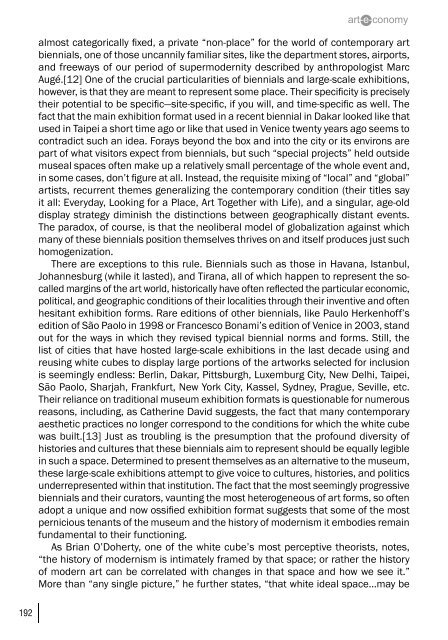art-e-conomy _ reader - marko stamenkovic
art-e-conomy _ reader - marko stamenkovic
art-e-conomy _ reader - marko stamenkovic
Create successful ePaper yourself
Turn your PDF publications into a flip-book with our unique Google optimized e-Paper software.
192<br />
almost categorically fixed, a private “non-place” for the world of contemporary <strong>art</strong><br />
biennials, one of those uncannily familiar sites, like the dep<strong>art</strong>ment stores, airports,<br />
and freeways of our period of supermodernity described by anthropologist Marc<br />
Augé.[12] One of the crucial p<strong>art</strong>icularities of biennials and large-scale exhibitions,<br />
however, is that they are meant to represent some place. Their specificity is precisely<br />
their potential to be specific—site-specific, if you will, and time-specific as well. The<br />
fact that the main exhibition format used in a recent biennial in Dakar looked like that<br />
used in Taipei a short time ago or like that used in Venice twenty years ago seems to<br />
contradict such an idea. Forays beyond the box and into the city or its environs are<br />
p<strong>art</strong> of what visitors expect from biennials, but such “special projects” held outside<br />
museal spaces often make up a relatively small percentage of the whole event and,<br />
in some cases, don’t figure at all. Instead, the requisite mixing of “local” and “global”<br />
<strong>art</strong>ists, recurrent themes generalizing the contemporary condition (their titles say<br />
it all: Everyday, Looking for a Place, Art Together with Life), and a singular, age-old<br />
display strategy diminish the distinctions between geographically distant events.<br />
The paradox, of course, is that the neoliberal model of globalization against which<br />
many of these biennials position themselves thrives on and itself produces just such<br />
homogenization.<br />
There are exceptions to this rule. Biennials such as those in Havana, Istanbul,<br />
Johannesburg (while it lasted), and Tirana, all of which happen to represent the socalled<br />
margins of the <strong>art</strong> world, historically have often reflected the p<strong>art</strong>icular economic,<br />
political, and geographic conditions of their localities through their inventive and often<br />
hesitant exhibition forms. Rare editions of other biennials, like Paulo Herkenhoff’s<br />
edition of São Paolo in 1998 or Francesco Bonami’s edition of Venice in 2003, stand<br />
out for the ways in which they revised typical biennial norms and forms. Still, the<br />
list of cities that have hosted large-scale exhibitions in the last decade using and<br />
reusing white cubes to display large portions of the <strong>art</strong>works selected for inclusion<br />
is seemingly endless: Berlin, Dakar, Pittsburgh, Luxemburg City, New Delhi, Taipei,<br />
São Paolo, Sharjah, Frankfurt, New York City, Kassel, Sydney, Prague, Seville, etc.<br />
Their reliance on traditional museum exhibition formats is questionable for numerous<br />
reasons, including, as Catherine David suggests, the fact that many contemporary<br />
aesthetic practices no longer correspond to the conditions for which the white cube<br />
was built.[13] Just as troubling is the presumption that the profound diversity of<br />
histories and cultures that these biennials aim to represent should be equally legible<br />
in such a space. Determined to present themselves as an alternative to the museum,<br />
these large-scale exhibitions attempt to give voice to cultures, histories, and politics<br />
underrepresented within that institution. The fact that the most seemingly progressive<br />
biennials and their curators, vaunting the most heterogeneous of <strong>art</strong> forms, so often<br />
adopt a unique and now ossified exhibition format suggests that some of the most<br />
pernicious tenants of the museum and the history of modernism it embodies remain<br />
fundamental to their functioning.<br />
As Brian O’Doherty, one of the white cube’s most perceptive theorists, notes,<br />
“the history of modernism is intimately framed by that space; or rather the history<br />
of modern <strong>art</strong> can be correlated with changes in that space and how we see it.”<br />
More than “any single picture,” he further states, “that white ideal space…may be


